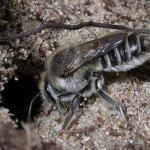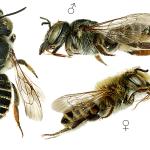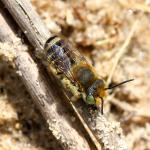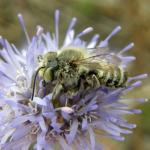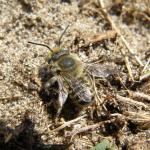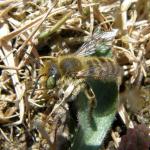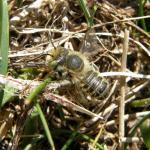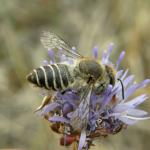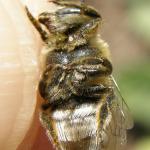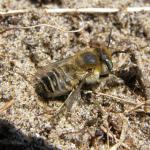Apis argentata FABRICIUS 1793; Apis albiventris PANZER 1798; Megachile saussurei RADOSZKOWSKI 1874; Megachile argentata fossoria FERTON 1909; Perezia maura FERTON 1914; Megachile leachella maadiensis VAN DER ZANDEN, 1986; Apis argentata auctt; Megachile dorsalis PEREZ 1879.
A small Megachile with green eyes in life. Tergite 6 of both sexes is clothed largely with adpressed white hairs and the female’s scopal hairs are also white. These characters readily distinguish this species from other Megachile species in Britain. Formerly known in the British literature by the names Megachile argentata and M. dorsalis.
Southern England and south Wales. Also known from the Channel Islands (Guernsey and Jersey), but not from Scotland and Ireland. The bee is often locally abundant. Widely distributed in the western Palaearctic, from southern Fennoscandia south to North Africa, and east to the Middle East. However, precise limits are not known owing to confusion with very closely related species that are frequently difficult to identify to species. In northern Europe the distribution of M. leachella is largely coastal.
This bee is not generally regarded as being scarce or threatened. Falk (1991), however, has listed it as a Notable B species.
Mainly found on coastal sand dunes. There are, however, a few inland sites, most of which are on sandy soils. For example, in June 2005, D Baldock (pers. comm.) encountered an extensive nesting aggregation in a sand pit at Wrecclesham, Surrey, and there are confirmed records from localities well inland in Hertfordshire and Suffolk.
Univoltine, June to late August.
Nest burrows are excavated in the soil. Occasionally nests occur in compact and extensive aggregations. Cut leaf sections from numerous species of plants have been reported, including petals of common bird’s-foot-trefoil (Lotus corniculatus). Nests have been described by Grandi (1961) and by Holm & Skou (1972).
Common and greater bird’s-foot-trefoil (Lotus corniculatus & L. pedunculatus), brambles (Rubus fruticosus agg.), white bryony (Bryonia dioica), wild carrot (Daucus carota), creeping cinquefoil (Potentilla reptans), hare’s-foot clover (Trifolium arvense), white clover (Trifolium repens), cowbane (Cicuta virosa), bloody crane’s-bill (Geranium sanguineum), germanders (Teucrium spp.), hawk’s-beards (Crepis spp.), lizard orchid (Himantoglossum hircinum), bog pimpernel (Anagallis tenella), ragwort (Senecio jacobaea), restharrow (Ononis sp.), sea-holly (Eryngium maritimum), sheep’s-bit (Jasione montana), squill (Scilla), English stonecrop (Sedum anglicum), thyme (Thymus sp.), viper’s-bugloss (Echium vulgare). Males have been found sheltering within the corollas of sea bindweed (Calystegia soldanella).
None confirmed for Britain. However, anecdotal evidence indicates that a small form of Coelioxys mandibularis (Megachilinae) on the east Kent coast (Deal, Sandwich and Pegwell Bay) may be a cleptoparasite of M. leachella in that region but, as yet, this remains to be confirmed. Coelioxys afra is reported to be a cleptoparasite of M. leachella in the Channel Islands (Richards 1979).
Profile written:
Proofed: February 2012


